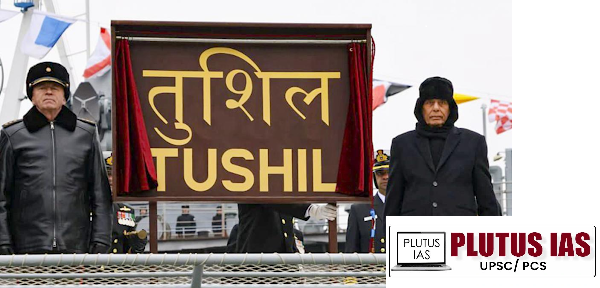20 Dec Prelims Bits: INS Tushil.
This article covers “Daily Current Affairs,” and the topic details related to Prelims Bits: INS Tushil.
Syllabus mapping:
GS: Recent advancements in the defense technology.
For Prelims:
What are the key features of the INS Tushil and Stealth-guided technology?
Why in the News?
India and Russia are entering a new era of collaboration by leveraging expertise in key areas like Artificial Intelligence, cyber security, space exploration, and counter-terrorism. Defence Minister Rajnath Singh highlighted this during the commissioning of the stealth-guided missile frigate INS Tushil into the Indian Navy on December 9, 2024, in Kaliningrad, Russia.

Key Facts: INS Tushil
Ship Overview
Type: Multi-role stealth guided missile frigate.
Built in: Kaliningrad, Russia.
Commissioning: 09 Dec 2024, by Hon’ble Raksha Mantri Shri Rajnath Singh.
History:
India decided to acquire two Admiral Grigorovich-class frigates in 2016.
Engines were sourced from Zorya-Mashproekt, Ukraine, due to the Ukrainian conflict.
Contract signed in October 2018 for ₹8,000 crore ($1.3 billion in 2023) for two frigates: Admiral Butakov renamed INS Tushil. Admiral Istomin was renamed INS Tamala.
Operational Objectives
Charter of Indian Navy: Diplomatic, military, and constabulary roles.
Joint Activities: Patrolling, maritime partnership exercises with various navies, including in piracy-prone regions.
Capability Building: During port visits, collaboration with host navies and military/government leadership.
Strategic Aims
1. Strengthening India’s maritime cooperation with littoral nations.
2. Engaging with the Indian diaspora in the region.
3. Demonstrating the Indian Navy’s commitment to safeguarding the global seafaring community.
4. Deployment: INS Tushil is set to conduct joint exercises, patrols, and maritime cooperation en route to India.
5. Capability: Enhances the Indian Navy’s blue-water operational capacity and diplomatic engagement.
Stealth Technology:
| Aspect | Details |
|---|---|
| Definition | Military tactics and countermeasures to reduce visibility to radar, infrared, sonar, etc. |
| Objective | Operate or hide without alerting enemy forces to the presence of personnel or equipment. |
| Applications | Aircraft, ships, submarines, missiles, satellites, ground vehicles, and military uniforms. |
| Methods | – Shape Design: Reduces radar detection by redirecting waves. |
| – Radiation-Absorbent Materials (RAM): Blocks radar signals. | |
| – Multi-Spectral Camouflage: Adapts to radar, visual, and infrared spectra. | |
| – Infrared Reduction: Chemicals applied to uniforms/vehicles reduce heat signatures. | |
| History | – Began in 1958 in the U.S. to counter Soviet radar tracking during the Cold War. |
| – Initial efforts focused on U-2 spy planes. | |
| – Expanded to include advanced stealth designs like the B-2 Spirit. | |
| Notable Example | Northrop Grumman B-2 Spirit Stealth Bomber. |
| Strategic Importance | – Mitigates advancements in radar, infrared tracking, and surface-to-air missile technologies. |
| – Tailored spectral signatures for specific detection threats. |
Download Plutus IAS Current Affairs (ENG) 20th Dec 2024
Prelims questions:
Q. The primary objective of stealth technology in military applications is:
a) Increase weapon firepower
b) Enhance the visibility of military assets
c) Reduce detectability to radar, infrared, and other detection systems
d) Improve communication range
ANSWER: C.




No Comments